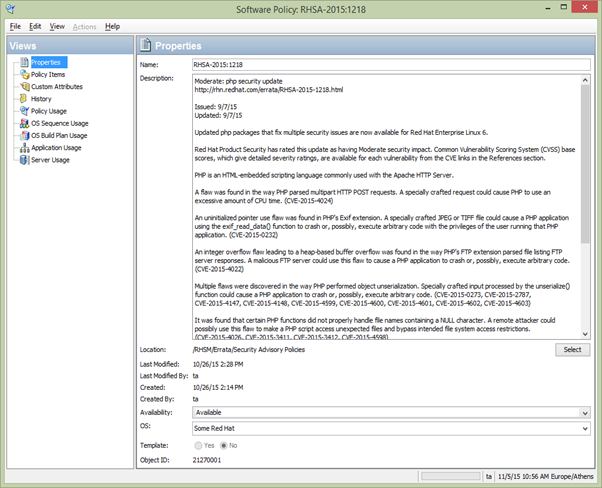Searching the Help
To search for information in the Help, type a word or phrase in the Search box. When you enter a group of words, OR is inferred. You can use Boolean operators to refine your search.
Results returned are case insensitive. However, results ranking takes case into account and assigns higher scores to case matches. Therefore, a search for "cats" followed by a search for "Cats" would return the same number of Help topics, but the order in which the topics are listed would be different.
| Search for | Example | Results |
|---|---|---|
| A single word | cat
|
Topics that contain the word "cat". You will also find its grammatical variations, such as "cats". |
|
A phrase. You can specify that the search results contain a specific phrase. |
"cat food" (quotation marks) |
Topics that contain the literal phrase "cat food" and all its grammatical variations. Without the quotation marks, the query is equivalent to specifying an OR operator, which finds topics with one of the individual words instead of the phrase. |
| Search for | Operator | Example |
|---|---|---|
|
Two or more words in the same topic |
|
|
| Either word in a topic |
|
|
| Topics that do not contain a specific word or phrase |
|
|
| Topics that contain one string and do not contain another | ^ (caret) |
cat ^ mouse
|
| A combination of search types | ( ) parentheses |
|
- Import Red Hat Errata and Channels in SA using SA Red Hat Importer tool
- RHN Classic, RHSM and Satellite
- Content import using Red Hat Subscription Management
- Entitlement certificates
- Install Red Hat CA certificates
- Content labels
- Sample use cases
- Migration
- Supported RHEL versions
- Reuse Red Hat import configuration file
- View errata based and channel based policies in the SA Client
View errata based and channel based policies in the SA Client
The rhn_import program allows you to create errata-based, erratum-based, and channel-based policies in the SA Client. After successfully running the program, you can view the properties of errata-based, erratum-based, and channel-based policies in the SA Client. You can view properties such as the SA user who created the software policy, the date when it was created, the name, the description, the availability, the location of the policy in the Library, the operating systems applicable to the policy and the SA Client ID of the software policy. HPE recommends that you do not edit the policies created by the rhn_import program.
To view the properties of a software policy:
- From the navigation pane, select Library > By Folder.
- Select the Red Hat Network Folder (RHN).
- From the content pane, select the errata-based or channel-based policy and open it. The policy window appears.
-
From the Views pane, select Properties. You can view the properties for the policy in the content pane.

-
Name: Contains the errata reference for the errata based software policy.
-
Description: Includes all the errata documentation for the errata.
-
Location: Specifies the location of the policy in the folder hierarchy. To change the location click select to specify the location for the policy in the folder hierarchy. The Select Location window appears. Select a folder in the Library to specify the location of the policy and then click Select.
-
Created: Corresponds to the time when the errata was downloaded by SA to create the software policy.
-
Last Modified: Corresponds to the time when the errata based policy was modified.
-
Availability: Contains the SA server life cycle values for the errata based software policy. The default value for an errata based policy is set to Available.
-
Platform: Specifies the operating systems applicable to the errata. You can expand the list to see the selected platforms.
-
-
To save the changes, select Save from the File menu.
Errata caching
When importing errata, SA Red Hat Import tool keeps track of the imported errata. Details of each imported erratum are stored in a cache file and subsequent runs will skip the cached errata completely. This improves performance as it avoids some calls to Red Hat and to SA Library. In the absence of the cached data these calls are being made even for errata that has not been modified and is up to date in the SA Library. Errata that has been modified by Red Hat is updated anyway so there is no danger of having outdated errata after import.
A cache file is created for each imported Red Hat Network channel / Red Hat Subscription Management content.
The cache files are kept in the following folder on the SA core server:
/var/opt/opsware/rhn_import
The file name uses the following pattern:
prev_import_ch_<label>.dat
where <label> is the Red Hat Network channel label or the Red Hat Subscription Management content label. Some example file names are presented below:
- prev_import_ch_rhel-x86_64-server-6.dat
- prev_import_ch_rhel-7-server-rpms{7Server-x86_64}.dat
As a result of the caching mechanism described above the following scenarios are possible:
- An erratum is imported into SA Library and then it is removed / renamed / moved to another folder. When
rhn_importorredhat_importare run next time, the erratum will not be reimported into the SA Library. This is because the erratum details are present in the cache file so it is skipped during the import. - The errata roll-up policy is created and then it is removed, renamed, or moved to another folder (for example, by using the SA Client). When
rhn_importorredhat_importare run next time the errata roll-up policy will be recreated but it will contain only the errata that has been previously published by Red Hat.
We welcome your comments!
To open the configured email client on this computer, open an email window.
Otherwise, copy the information below to a web mail client, and send this email to hpe_sa_docs@hpe.com.
Help Topic ID:
Product:
Topic Title:
Feedback:





